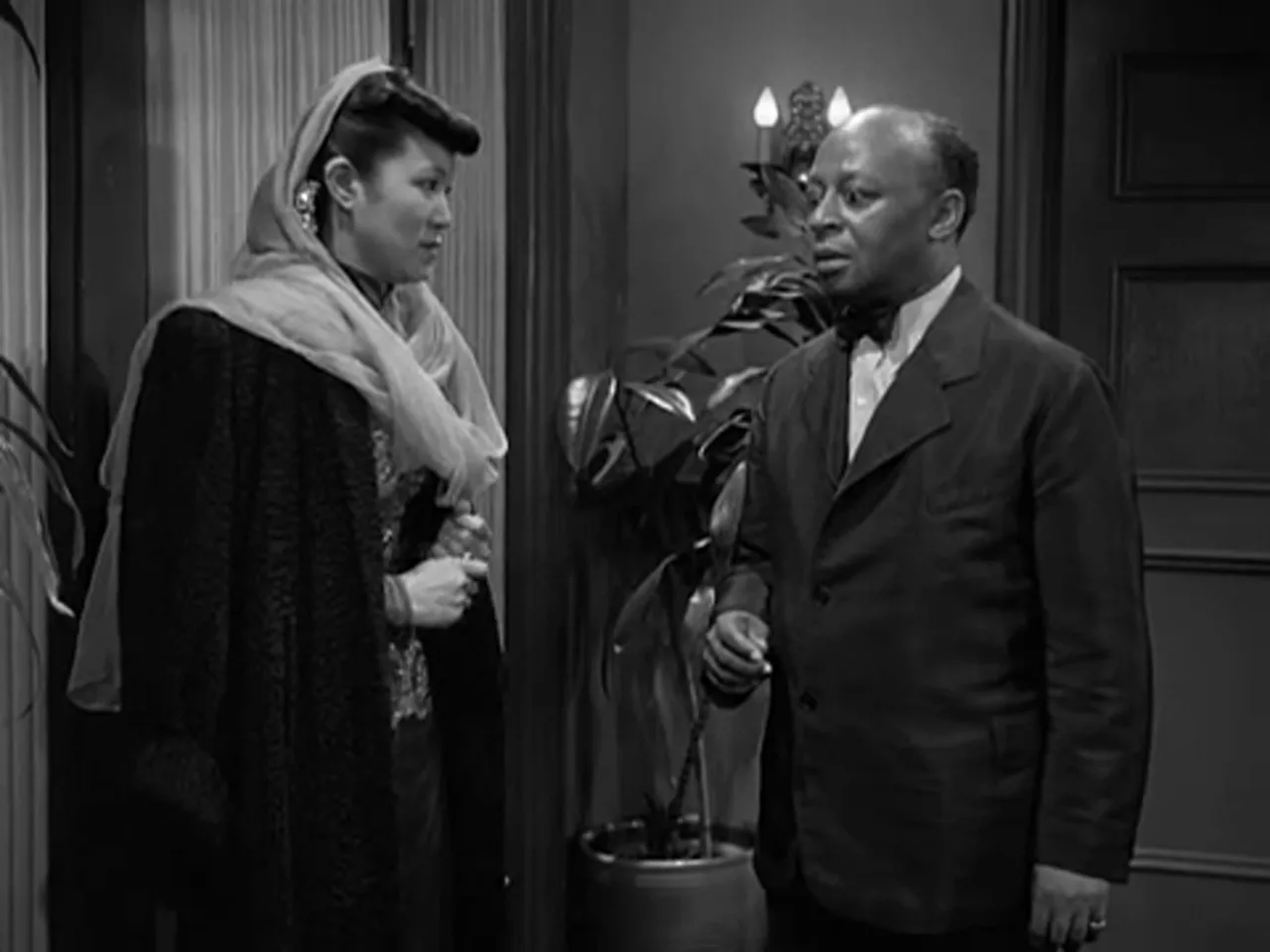The Chinese Ring, directed by William Beaudine and released by Monogram Pictures in December 1947, occupies a curious place in the landscape of mid‑century American genre cinema. Presented here with the gravitas of a classic film noir movie observer, the critic considers how a mystery film built for the Poverty Row studio system borrows, resists, and refracts the dark mores of noir while remaining rooted in the long‑running Charlie Chan tradition. This essay reads The Chinese Ring as a kind of small‑scale film noir movie: a tightly compressed crime drama that traffics in ambiguity, greed, and a complex moral knot of deception.
As a film noir movie curiosity, The Chinese Ring presents a compact 68‑minute narrative that strings together a murder, a vanished fortune, a smuggling plot, and a surprising culprit. The production is notable for introducing Roland Winters as Charlie Chan and for recycling a familiar template: a W. Scott Darling script lineage that traces back through Mr. Wong in Chinatown (1939) and Murder at Midnight (1931). The film's economy of means, its shadowy motives, and the presence of moral ambivalence place it near the orbit of the film noir movie sensibility even as it remains, by classification, a mystery film.
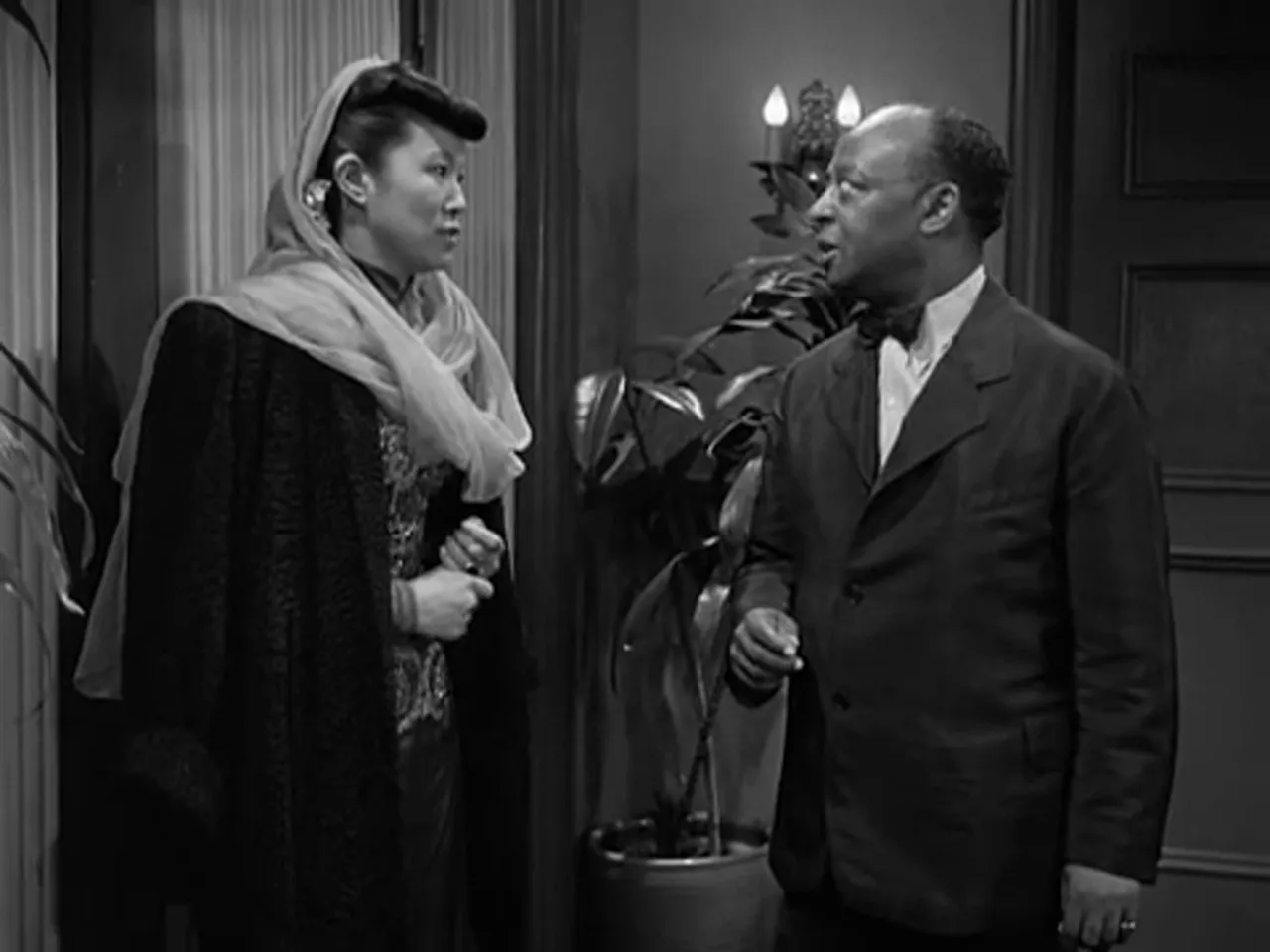
Outline
- Introduction and historical placement
- Plot summary and key beats
- Principal performances and casting choices
- Direction, screenplay lineage, and Monogram production context
- A formal reading: noir resonances and stylistic notes
- Representation, cultural framing, and a modern critical perspective
- Concluding assessment and why classic film fans should revisit this film
Introduction and Historical Placement
The Chinese Ring is the product of a postwar moment when Hollywood’s studio system still produced steady genre fare for neighborhood theaters and double bills. As a film noir movie of modest budget and brisk runtime, it demonstrates how smaller studios like Monogram Pictures could supply audiences with tightly plotted entertainment that nonetheless engaged—implicitly and sometimes explicitly—with darker themes. The film’s release on December 6, 1947 positioned it amid an era of cynicism and reconstruction, when audiences were open to stories about corruption, betrayal, and crime trading hands behind closed doors.
Although classified as a mystery film, The Chinese Ring often feels like a film noir movie in miniature: it traffics in shadows both literal and ethical, and its narrative is propelled by money, deception, and a chain of poor choices. The movie’s pedigree—screenplay work by W. Scott Darling adapted from earlier scripts—helps explain its lean plotting and its reliance on tried‑and‑true twists. The film also inaugurated Roland Winters in the role of Charlie Chan, a fact that shaped its reception and continuing interest among classic movie enthusiasts.
Plot Summary: The Mystery Unspools
At the story’s opening, a Chinese princess—Princess Mei Ling—visits Charlie Chan’s residence in San Francisco. She presents a small heirloom ring and then, in a scene both brief and decisive, is killed by a dart fired through a window. Charlie Chan, ever the methodical investigator, examines the ring and the scene. He finds a single clue: a scrawled note bearing the name “Captain K.” The note, and the princess’ sudden, violent death, become the pivot for an investigation that rapidly expands to encompass a million‑dollar draft, smuggled fighter‑planes, and a tangle of collaborators and conmen.
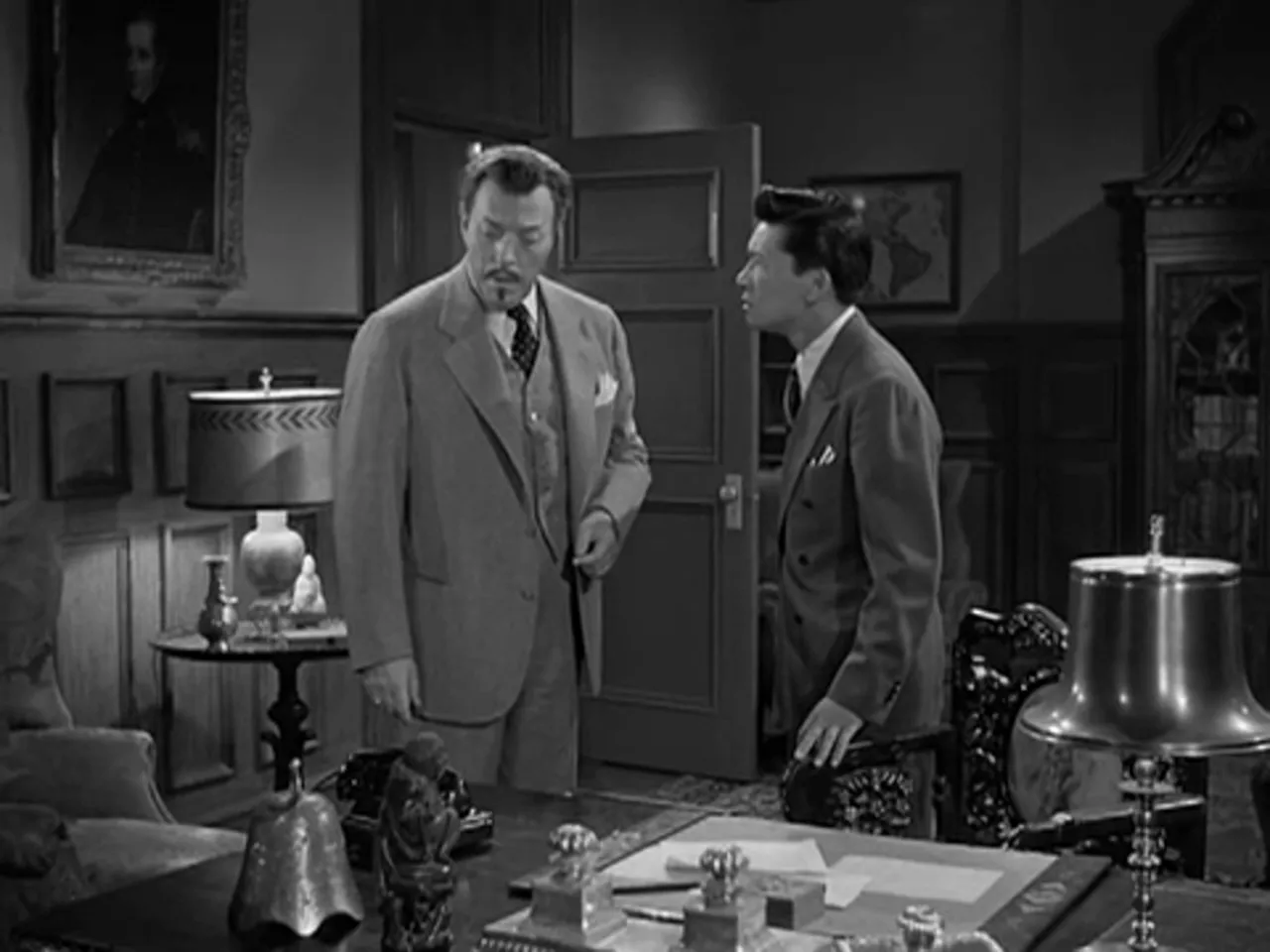
The narrative accelerates quickly: Chan learns that the princess carried a draft from her home bank for one million dollars and that she cashed nearly the entire sum in San Francisco. A significant portion of that money is traced to a check cashed by Captain Kelso; other withdrawals are recorded in Chinese cursive signatures that suggest a complex financial trail. Chan’s inquiries take him to a cargo ship, an old airplane hangar in Burbank, a city bank, the Princess’ Chinatown apartment, and finally onto a passenger vessel where the final confrontation takes place.
Along the way the film gathers a roster of suspects and pawns: Captain Kong and Captain Kelso (two men who arrived with the Princess), a banker named Armstrong who handles the Princess’ funds, a curious reporter named Peggy Cartwright who insists on being part of the story, Chan’s loyal but comic butler Birmingham Brown, Chan’s son Tommy Chan, and the Princess’ maid and a deaf‑mute boy who becomes crucial to the mystery. Murders multiply: the maid is found dead; a young boy disappears and is later revealed to have been murdered and secretly buried. The film keeps its pace taut, and those thematic obsessions—greed, deception, and the idea that appearances conceal direer truths—remain constant.
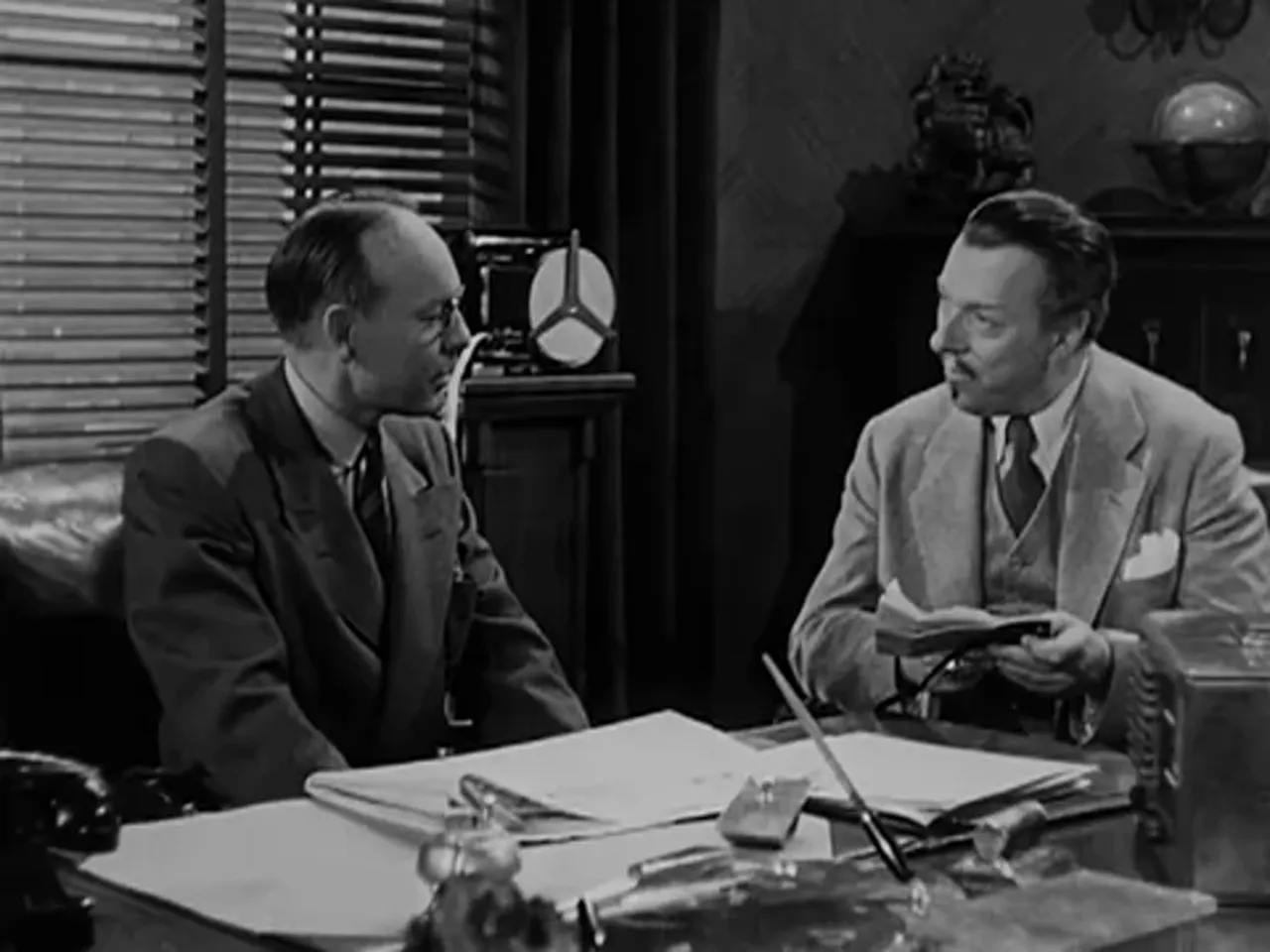
Principal Performances and Casting Choices
In the central role, Roland Winters assumes the mantle of Charlie Chan. Winters’ Chan is steady, unflappable, and methodical; he speaks with aphoristic wit that offers relief among the darker beats of the story. In this installment the character’s signature wise sayings—lines like “Politeness golden key to many doors”—provide a cultural tonal anchor that guides the audience through a network of suspicion. The role of Chan had been played by other actors in earlier films, and Winters’ debut in the part marks a pivot point for fans and critics alike.
Louise Currie’s Peggy Cartwright supplies the film’s modern‑sensible energy: determined, persistent, and at times a narrative provocation. Her insistence on participating in the investigation—clambering into apartments, pressing for interviews, and taking notes—adds an urban, press‑driven sensibility that the film leans on for certain forward momentum. Curtly put, Peggy is the archetypal righthand woman reporter who refuses to be sidelined.
Warren Douglas as Sgt. Bill Davidson plays the law-and-order counterbalance, pumping the plot with institutional muscle and procedural drive. Mantan Moreland’s Birmingham Brown is the film’s comic foil, and the role often sits at the uncomfortable intersection between levity and period stereotyping. Barbara Jean Wong gives the Princess Mei Ling brief but crucial work as the doomed figure whose death propels the entire plot; her presence is the moral fulcrum of the mystery.
Philip Ahn and Thayer Roberts, as Captain Kong and Captain Kelso respectively, are cast as shadowy entrepreneurial figures whose desire for profit renders them suspect. Byron Foulger’s Armstrong emerges late as a man whose polished banker’s demeanor conceals a decisive and chilling moral corruption. The film keeps its reveals tight and its suspects multiplying until the end, and the cast carries that momentum with generally competent, screen‑efficient performances.
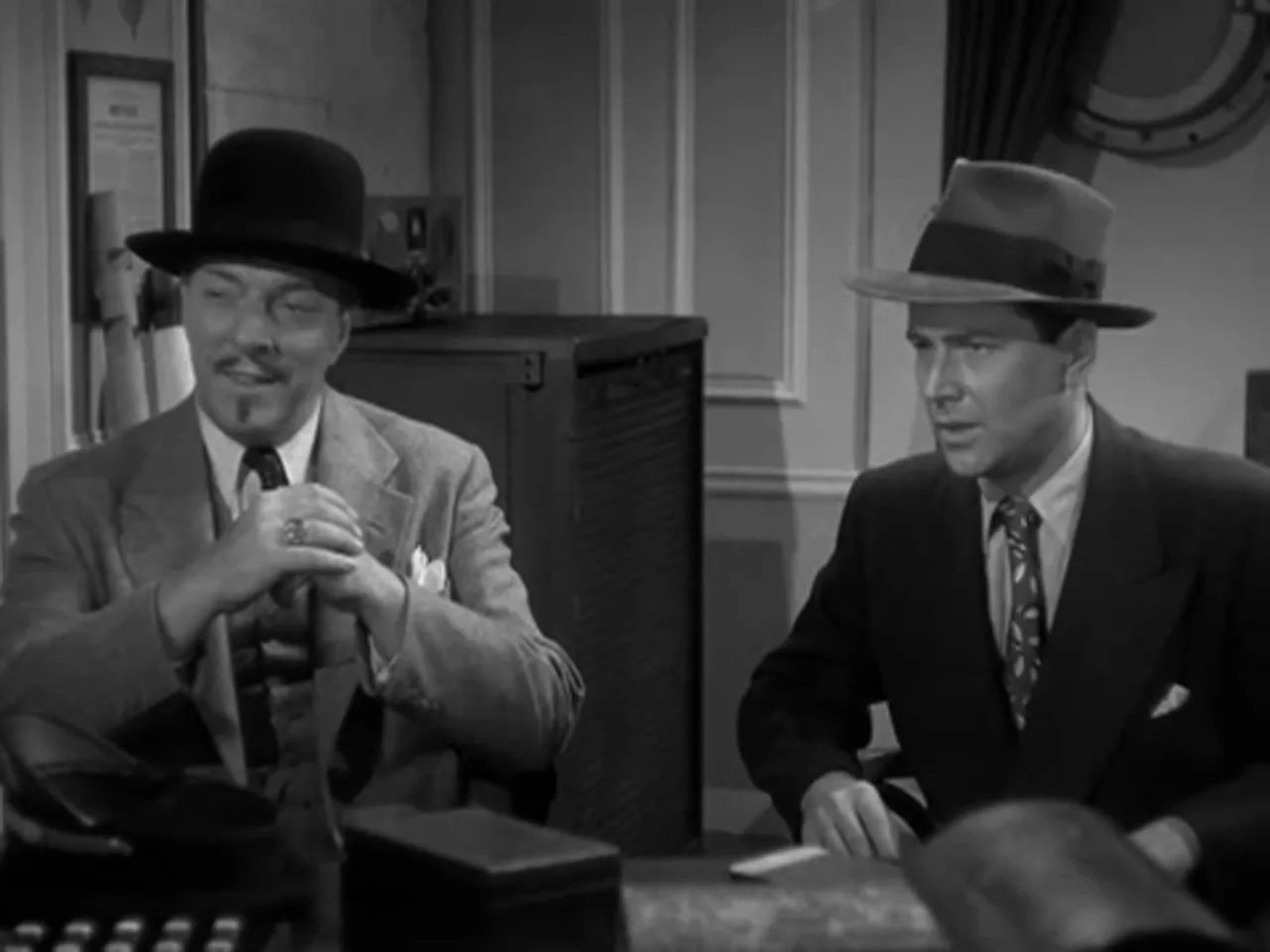
Direction, Screenplay Lineage, and Monogram Production Context
William Beaudine, an industrious director with a long career across studio and independent productions, guides The Chinese Ring with a clear eye toward economy and pace. At 68 minutes, the film leaves no room for indulgence; Beaudine’s direction pushes the narrative forward briskly and without theatrical excess. The film’s screenplay credits W. Scott Darling, whose script draws on a lineage of recycled material: The Chinese Ring is a remake of the 1939 Monogram film Mr. Wong in Chinatown and bears structural similarities to the 1931 Murder at Midnight. That lineage is important: it explains the film’s efficient plotting, its reliance on archetypal suspects, and its succinct delivery of the twist ending.
Monogram Pictures, the production company, specialized in this kind of tightly budgeted crime and mystery fare. Monogram’s business model—low budgets, fast shoots, and reliable genre formulas—meant that films like The Chinese Ring needed to capture audience interest through compact plotting, crisp performances, and recognizable story beats rather than through lavish production values. This economic constraint often sharpened the films’ narrative focus; The Chinese Ring benefits from that urgency. The film’s production limitations align it with the broader family of studio‑era B pictures that often provided fertile terrain for experimentation with darker atmospheres and moral ambiguity—hence its kinship, at least in tone, with what many think of as the film noir movie category.
Script and Genre Recycling
The screenplay’s close relationship with Darling’s earlier work is more than a historical curiosity: it accounts for how The Chinese Ring telescopes motive and misdirection into a compact format. That method—reconfiguring similar narrative skeletons for different detective figures—was common practice and often produced highly effective results. In The Chinese Ring, familiar components—an international money transfer, the signature on a check, a small but telling heirloom, a masked intruder—are rearranged to serve a new detective figure and a new moral logic. For a critic looking through the lens of film noir movie affinities, the script’s repeated motifs of betrayal and the corrosive power of money are especially resonant.
Noir Resonances: Why The Chinese Ring Reads Like a Film Noir Movie
To call The Chinese Ring a film noir movie is both provocative and useful. The film does not wear the formal hallmarks of high‑style noir—there is none of the expressionistic photography associated with major studio noirs—yet it shares many thematic affinities with noir proper. The corruption of trust, the corruptibility of commerce, the fatal consequences of greed, and the film’s resolute unwillingness to give easy moral closure all place it in aesthetic conversation with mid‑century noir narratives.
Consider the following motifs that allow The Chinese Ring to be read as a film noir movie cousin:
- Money as motive and moral contagion: The million‑dollar draft is the film’s heart. Money acts as a toxin that prompts betrayal, forgery, and murder. The repeated bank transactions—cashier’s checks, daily withdrawals, and a vanished balance—supply the narrative engine and suggest a world where financial instruments obscure human responsibility.
- The false friend: The film’s twist—that the apparently respectable banker Armstrong is the murderer—mirrors noir’s fondness for revealing evil beneath a respectable surface. The revelation reframes earlier scenes and forces the audience to retroactively question every courteous encounter.
- Urban spaces and hidden corridors: Although the film does not luxuriate in metropolitan chiaroscuro, it uses urban locations—Chinatown apartments, banks, piers, and an old hangar—to suggest a city riddled with hidden commerce and secret passageways. These spaces are more claustrophobic than scenic, helping to build a sense of entrapment consistent with noir mood.
- Ambiguous gender dynamics and the press figure: Peggy Cartwright is not a femme fatale, but her restless presence and insistence on agency create a modern, unsettled gender energy. The film plays with the newsroom as a space where truth is pursued aggressively—another feature often present in film noir movie narratives.
These elements, combined with the film’s brisk pace and its undercurrent of moral unease, justify a critic’s use of the film noir movie frame even while acknowledging that The Chinese Ring is, by classification and by studio marketing, a mystery picture. The result is an intriguing hybrid: a mystery film that thinks like a film noir movie about the corrosive effect of money and the fragile credibility of civic institutions.
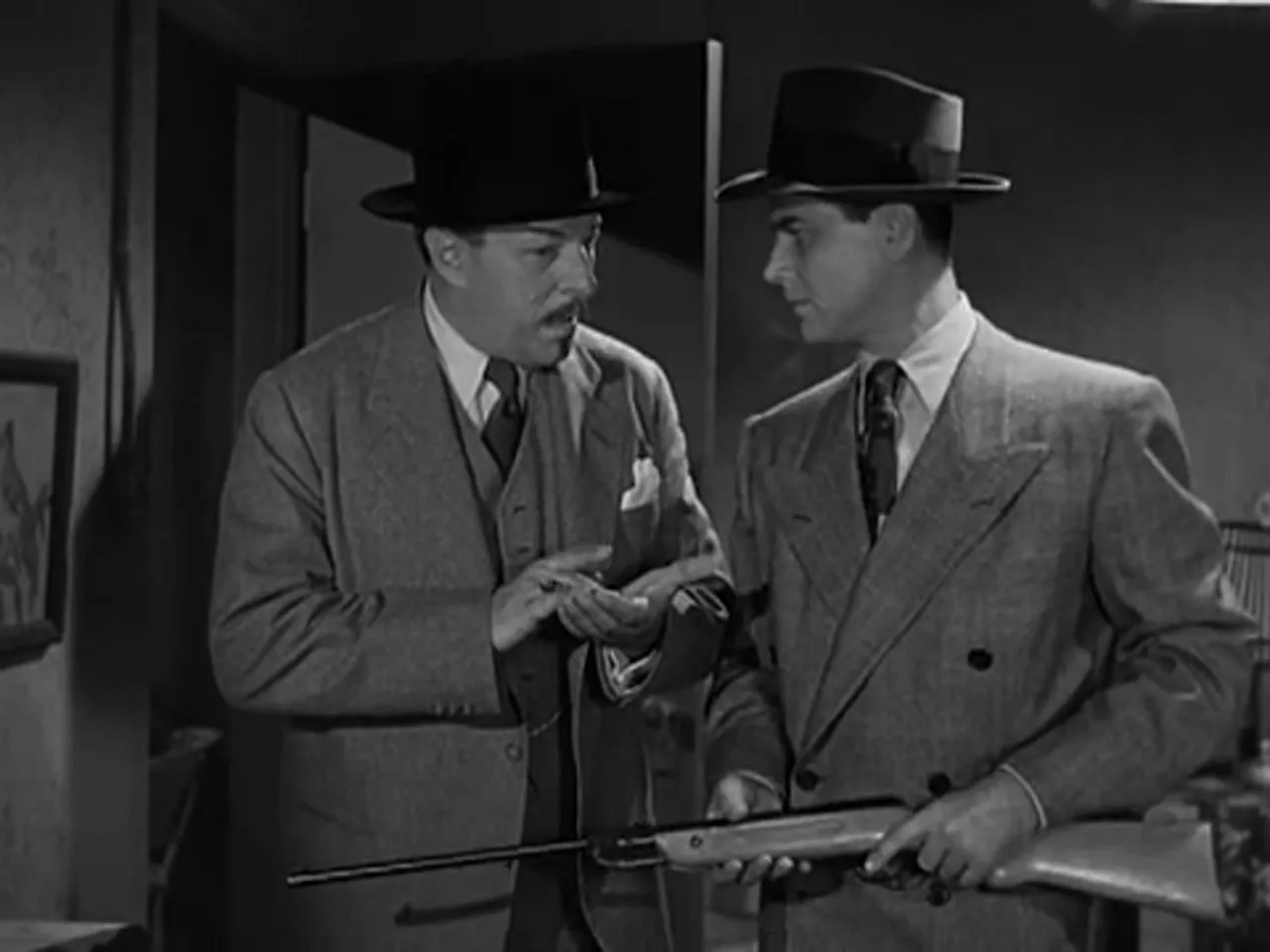
Key Scenes and Their Critical Weight
Certain scenes in The Chinese Ring crystallize its strengths and weaknesses and are worth close critical attention. The opening parlor scene—where the Princess arrives, gives a ring, and is murdered by a dart-driven blow through the window—establishes the film’s tonal balance: intimacy abruptly ruptured by violence. This economy of juxtaposition—everyday domesticity interrupted by a lethal theft of privacy—fuels the film’s momentum.
The bank sequences are also crucial. The discovery that the Princess carried a draft for one million dollars, and that she cashed nearly the entire sum in various increments, frames the story’s investigative energy. These scenes are where the plot’s arithmetic—the who‑got‑what of the money—becomes legible to Chan and to the audience. The revelations are matter‑of‑fact and procedural, and they contrast with the more melodramatic murder moments to create a balanced rhythm that is both analytic and atmospheric.
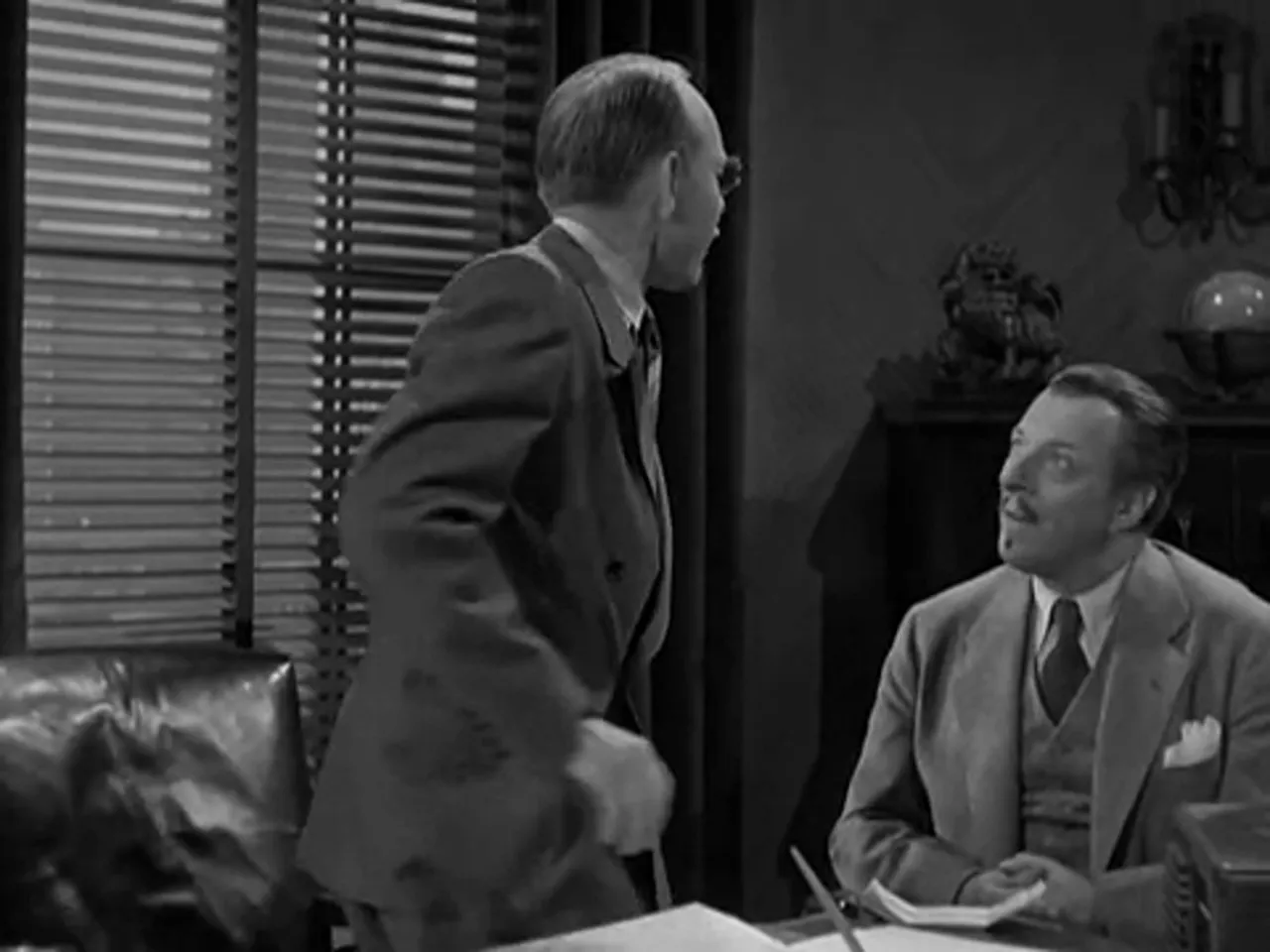
The shipboard kidnapping and final confrontation is the film’s action set piece. Monogram’s limitations are invisible here; the scene’s tension is driven by confined spaces and the film’s ability to turn a passenger vessel into a temporary crucible of guilt and exposure. When the film finally reveals Armstrong as the villain, the scene works because the narrative has laid down a systematic trail of financial misdirection that can be piece‑by‑piece exposed.
Representation and Cultural Framing
A modern critical ear must wrestle with the film’s cultural framing. The Chinese Ring is part of a long cinematic tradition that featured Chinese characters and Chinatown settings through the prism of American studio storytelling. In its casting and characterization, the film reflects the period’s conventions and limitations. Roland Winters, an American actor, plays Charlie Chan, a fact consistent with the Chan series’ complicated casting history. While Roland Winters’ performance is respectful in tone and narratively functional, contemporary critics cannot ignore the larger cultural context in which Asian characters were often mediated through the sensibilities of Hollywood’s mainstream imagination.
Similarly, the presence of actors such as Philip Ahn and Barbara Jean Wong foregrounds the film’s reliance on Asian‑themed story beats and the exoticization of elements like the Princess’ heirloom ring and her overseas political context. The film presents an international backstory—airplanes to be bought for an army back home, political stakes implied—without endorsing any one perspective; the international material functions primarily as a plot device. A modern viewer may find the film’s handling of these elements both of historical interest and ethically complicated: they provide authentic period texture, but they also reveal how studio narratives used foreignness as a shorthand for intrigue.
Technical Notes: Cinematography, Editing, and Music
William A. Sickner’s cinematography and the editing team, including Richard V. Heermance and Ace Herman, keep the film moving with a functional clarity typical of Monogram product. The visual approach prioritizes narrative legibility over stylistic flourishes; nonetheless, the film’s camera work often captures the cramped intimacy of apartments and the tense corridors of a ship with a practical economy that supports suspense. Edward J. Kay’s musical cues underscore these moments without overwhelming them: the score performs the usual service of accenting motive and signaling danger.
As a film noir movie adjacent piece, the film’s lighting tends toward straightforward illumination rather than the heavy chiaroscuro of major noir productions. That makes The Chinese Ring feel more like a clean, well‑constructed mystery with noir inflections rather than a formal exemplar of noir. This is also part of the film’s charm: it demonstrates how genre conventions can migrate across budgetary levels and still produce an affective, suspenseful experience.
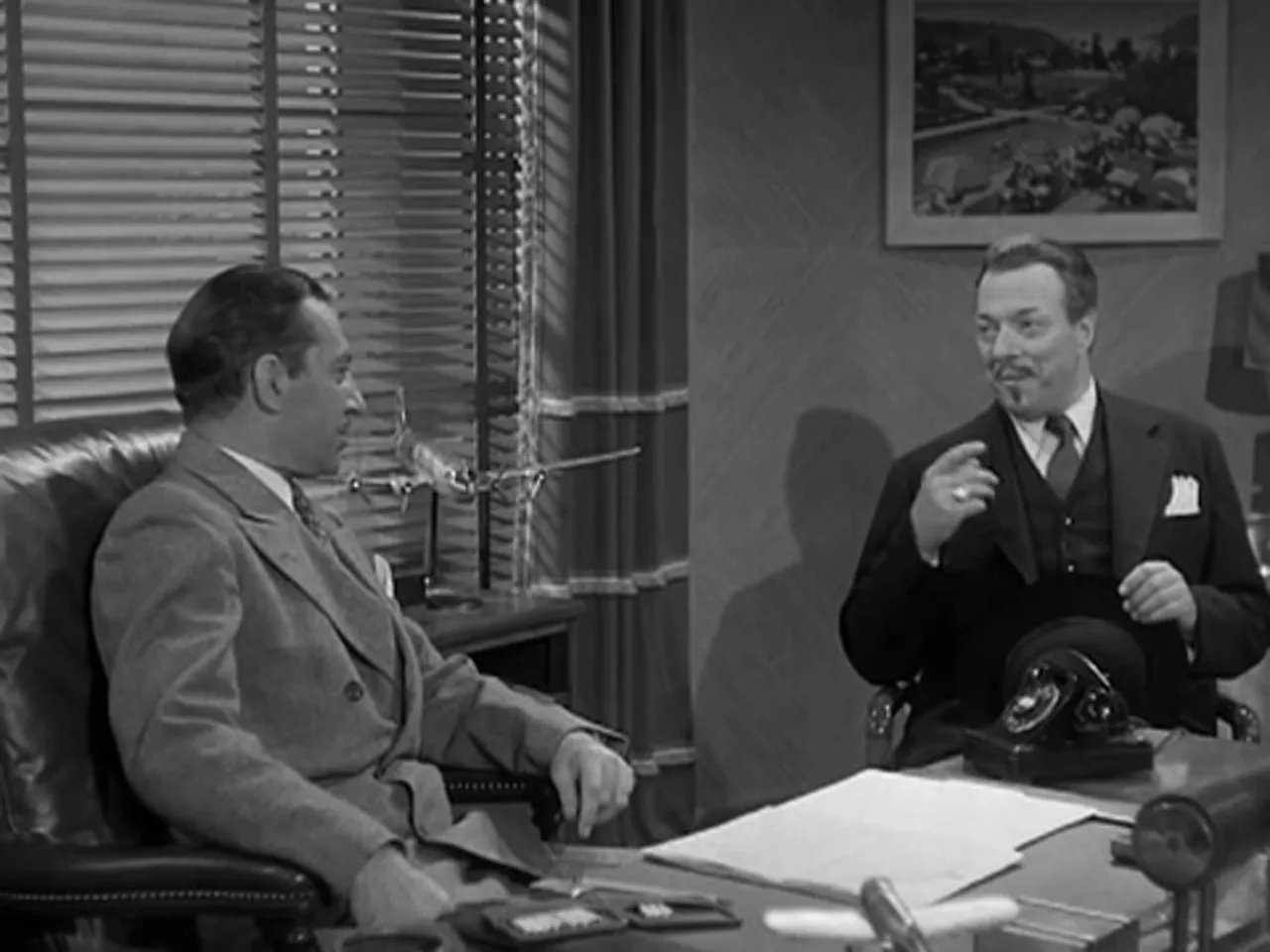
Comparative Context: Remake, Recycling, and the W. Scott Darling Thread
The film’s status as a remake—reworking Mr. Wong in Chinatown’s storyline—points to a broader studio practice of recycling functional narratives across detective franchises. W. Scott Darling’s writing provides a durable architecture: a foreign visitor’s murder, a bank draft, a fraudulent company (the Kelso Aviation Company in this case), and a chain of betrayals that culminates in a disguised, respectable villain. For critics interested in the film noir movie genealogy, this kind of recycling illuminates how key noir concerns—corruption, betrayal, the subterranean economy—could be repurposed for different titular sleuths and varying production conditions.
That lineage also figures into the film’s construction of suspense. The audience familiar with earlier versions might anticipate certain turns; yet, for an audience encountering The Chinese Ring in isolation, the film’s final act remains effective because it ties together its financial breadcrumbs convincingly. The cleverness of the twist is not purely in surprise—it is in the film’s ability to lead the viewer, step by step, to an explanation that reframes the earlier social pleasantries of banking and civility into instruments of deception.
Critical Assessment: Strengths and Limitations
Strengths of The Chinese Ring are evident in its pacing, its compact plotting, and its ability to deliver a satisfactory twist within a constrained runtime. William Beaudine keeps the film lean and precise; the cast delivers reliable turns; and the screenplay, despite its recycled origins, constructs a satisfying logic of motive. The film’s noir resonances—greed as corruption, the false friend, the city as a labyrinth—give it a thematic thickness beyond mere plot mechanics. For viewers who enjoy methodical detective work and narrative economy, the film is an engaging, efficient piece of entertainment.
Limitations include the production’s inevitable budgetary constraints, which limit visual scope; moments of period stereotyping that modern viewers will find problematic; and a script that occasionally relies on expository shorthand. The comedic interjections—chiefly supplied by Birmingham Brown—sometimes undercut the seriousness of the crimes depicted and can feel tonally uneven. Additionally, the film does not pursue the stylistic risks of contemporary high‑end noirs; it remains a genre exercise, expertly assembled but not formally adventurous.
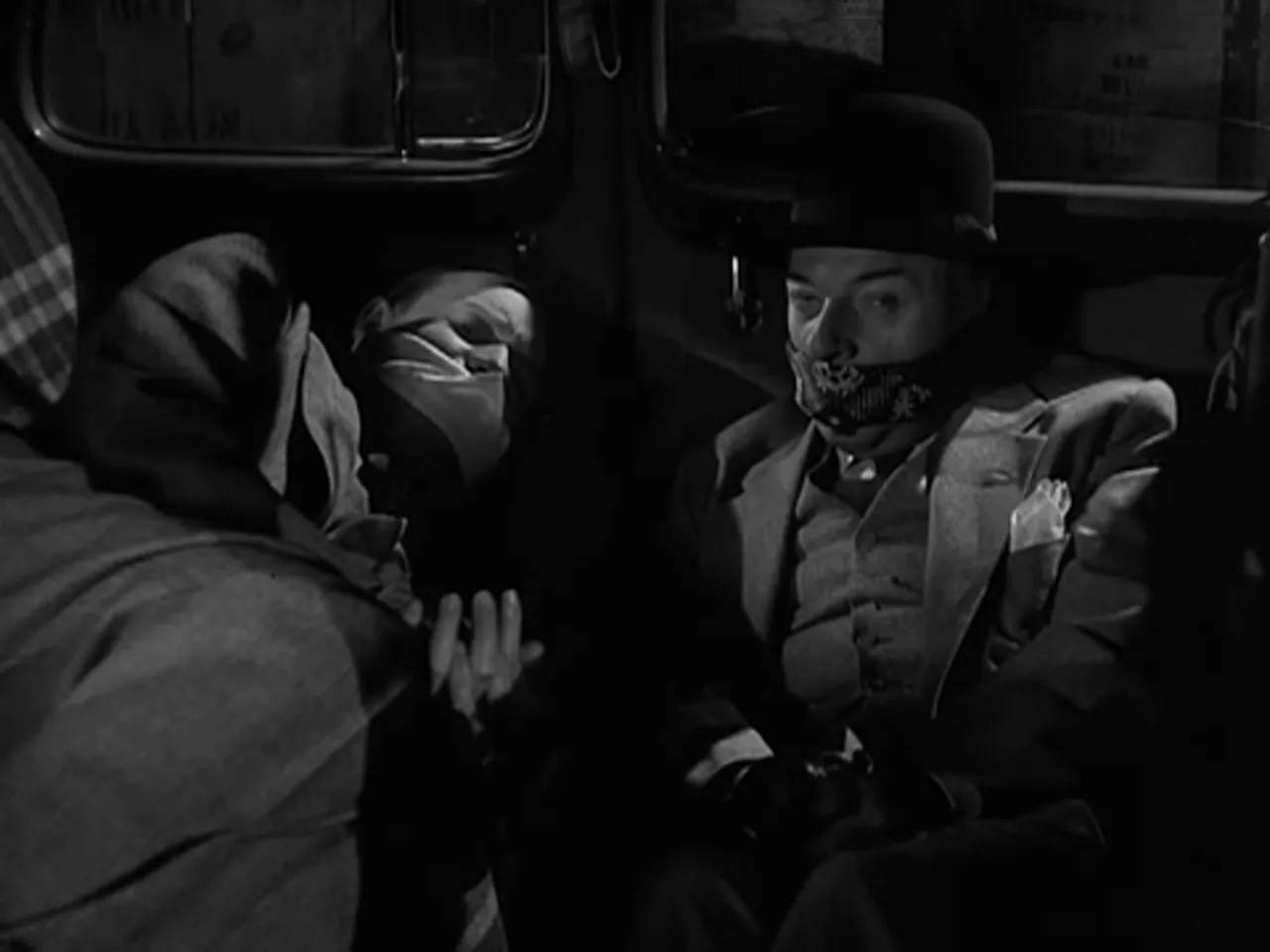
Why Classic Audiences and Film Students Should Revisit The Chinese Ring
For aficionados of classic cinema and students of genre history, The Chinese Ring is a compact case study in mid‑century B‑mystery filmmaking. It demonstrates how the constraints of small studio production can yield a taut, effective crime drama that shares concerns with the film noir movie oeuvre without replicating its look. The film represents a phase in the Charlie Chan series—namely the debut of Roland Winters—that is important for understanding how long‑running franchises adapted and persisted across changing audience tastes and studio economics.
Moreover, the film offers a lesson in narrative craftsmanship: within limited runtime, the screenplay builds causal clarity. The bank records, the forged signatures, and the sequence of withdrawals function as evidentiary clues leading to Armstrong’s exposure. This is the sort of detective logic that students of screenwriting can study as a model for economical plotting. For those who like their mysteries with a financial core rather than a purely psychological one, The Chinese Ring offers a blueprint for motive‑driven storytelling.
Closing Reflections: The Chinese Ring in the Shadow of Noir
The Chinese Ring is best appreciated when considered as a companion piece to the film noir movie tradition: it shares noir’s thematic obsessions—corruption, betrayal, the corrupting influence of money—while preserving the structural clarity of classical detective narratives. In that sense it is an accessible doorway into noir’s moral universe, particularly for viewers who prefer plot articulation alongside moral ambiguity.
As a cinematic artifact, the film is also valuable for what it reveals about the studio system’s capacity to adapt and recycle stories for differing detective heroes. It stands as an example of how small studios like Monogram could continue to deliver quality genre fare that resonated with audiences, even when resources were limited. For historians, the film serves as a reminder that the noir sensibility radiated beyond mainstream studio pictures and was detectable, in varying degrees, across the industry’s strata.
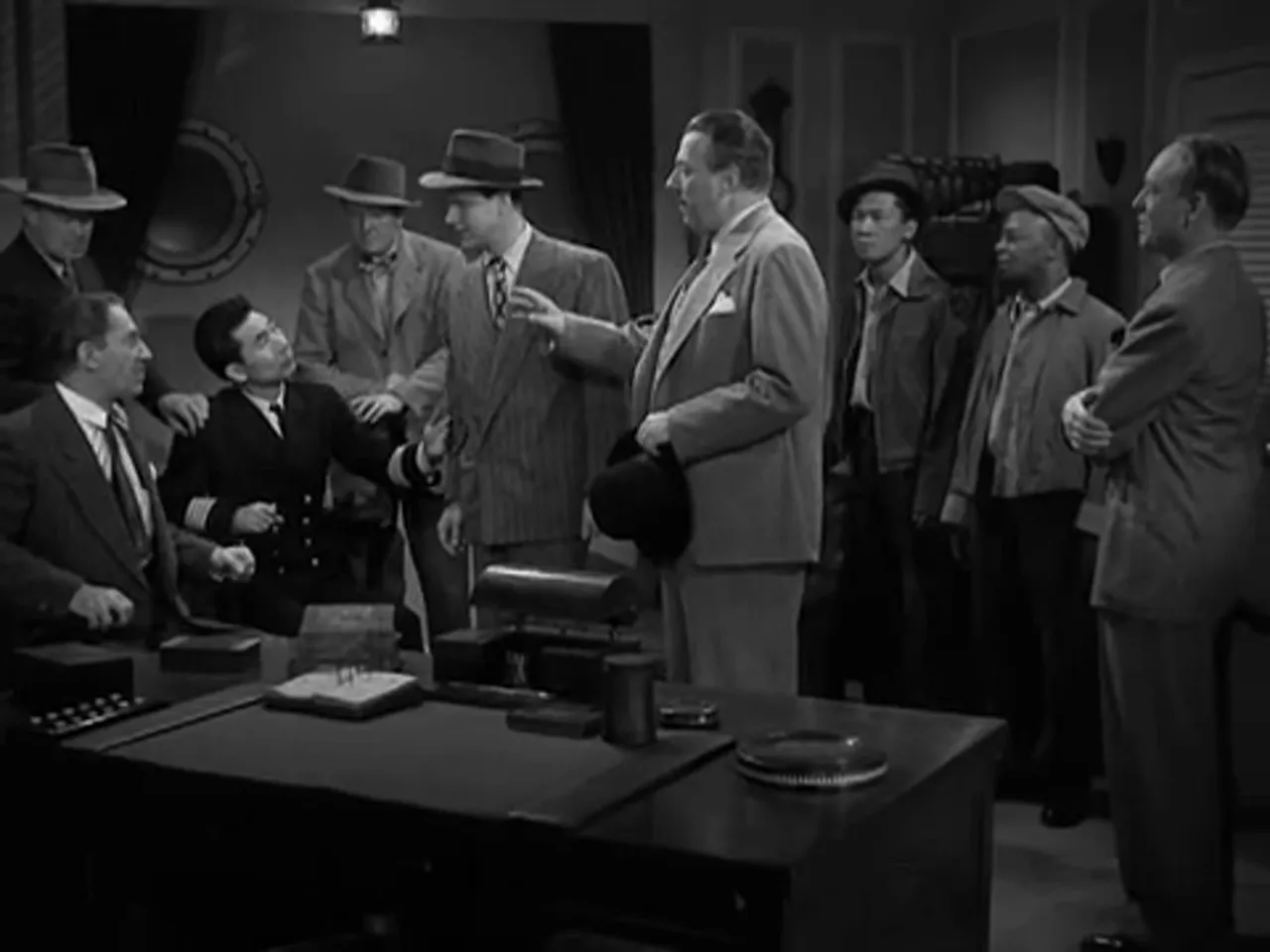
Selected Quotations and Notable Lines
“Death, my son, is the reckoning of heaven.”
This line—spoken early—captures the film’s fatalistic tone and Chan’s role as philosophical interpreter of crime.
“Politeness golden key to many doors.”
A Chan aphorism that functions as both a laugh line and thematic statement about social access and hidden motives.
“Luck, happy chain of foolish accidents.”
A wry summation of how chance and error can conspire to produce justice in tightly plotted mysteries.
Recommendation for Viewers and Collectors
Viewers who appreciate compact, well‑made detective stories, and who want to trace noir influences beyond the canonical pictures, will find The Chinese Ring a rewarding watch. It is especially recommended to those who study the Charlie Chan series or who are interested in how low‑budget studios handled cross‑cultural intrigue and financial crime narratives. Collectors of Monogram Pictures releases and students of W. Scott Darling’s adaptable plotting will also find this 1947 film an instructive and enjoyable entry.
Finally, for readers and cinephiles inclined toward the film noir movie tradition, revisiting The Chinese Ring allows an appreciation of how noir’s moral and thematic concerns echoed across different budgetary realities and storytelling traditions. The film is not a pure specimen of noir; it is an allied species. That alliance is instructive: noir was not a monolith, and its ideas permeated the wider world of mid‑century genre filmmaking—often in surprising and productive ways.
Further Reading and Viewing
- The Chinese Ring (1947) — directed by William Beaudine. Monogram Pictures. Watch for narrative economy and the Armstrong reveal.
- Compare with Mr. Wong in Chinatown (1939) — the earlier film that shares the plotline; useful for comparative study of script adaptation.
- Explore W. Scott Darling’s earlier scripts to see how motifs and mechanics were recycled across decades of mystery filmmaking.
Invitation from the Critic
For the reader who treasures classic cinema, the critic recommends revisiting The Chinese Ring not only as a mystery but as a compact example of filmic moral inquiry in the late 1940s. Those who enjoy the film noir movie mindset—curious about how noir’s concerns spread outward—will find this title an illuminating case. The film rewards repeat viewings: each pass reveals another carefully planted clue, another shifty smile, another small social gesture that, when connected, reveals the full calculation of motive and method.
For those who wish to delve deeper into the Charlie Chan canon and the work of Monogram Pictures, the film provides a useful reference point: it is the moment Roland Winters takes on an iconic role and a reminder that even modest studios produced stories with shades of noir that still resonate with contemporary viewers.
